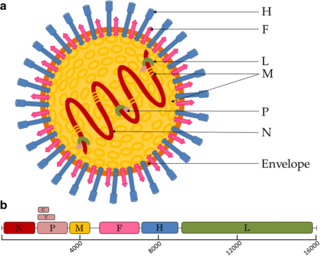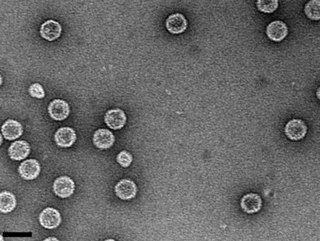
Flaviviridae is a family of enveloped positive-strand RNA viruses which mainly infect mammals and birds. They are primarily spread through arthropod vectors. The family gets its name from the yellow fever virus; flavus is Latin for "yellow", and yellow fever in turn was named because of its propensity to cause jaundice in victims. There are 89 species in the family divided among four genera. Diseases associated with the group include: hepatitis (hepaciviruses), hemorrhagic syndromes, fatal mucosal disease (pestiviruses), hemorrhagic fever, encephalitis, and the birth defect microcephaly (flaviviruses).

Paramyxoviridae is a family of negative-strand RNA viruses in the order Mononegavirales. Vertebrates serve as natural hosts. Diseases associated with this family include measles, mumps, and respiratory tract infections. The family has four subfamilies, 17 genera, and 78 species, three genera of which are unassigned to a subfamily.

Hepadnaviridae is a family of viruses. Humans, apes, and birds serve as natural hosts. There are currently 18 species in this family, divided among 5 genera. Its best-known member is hepatitis B virus. Diseases associated with this family include: liver infections, such as hepatitis, hepatocellular carcinomas, and cirrhosis. It is the sole accepted family in the order Blubervirales.

Geminiviridae is a family of plant viruses that encode their genetic information on a circular genome of single-stranded (ss) DNA. There are 520 species in this family, assigned to 14 genera. Diseases associated with this family include: bright yellow mosaic, yellow mosaic, yellow mottle, leaf curling, stunting, streaks, reduced yields. They have single-stranded circular DNA genomes encoding genes that diverge in both directions from a virion strand origin of replication. According to the Baltimore classification they are considered class II viruses. It is the largest known family of single stranded DNA viruses.

Barnaviridae is a family of non-enveloped, positive-strand RNA viruses. Cultivated mushrooms serve as natural hosts. The family has one genus, Barnavirus, which contains one species: Mushroom bacilliform virus. Diseases associated with this family includes La France disease.

Nodaviridae is a family of nonenveloped positive-strand RNA viruses. Vertebrates and invertebrates serve as natural hosts. Diseases associated with this family include: viral encephalopathy and retinopathy in fish. There are nine species in the family, assigned to two genera.

Tombusviridae is a family of single-stranded positive sense RNA plant viruses. There are three subfamilies, 17 genera, and 95 species in this family. The name is derived from Tomato bushy stunt virus (TBSV).
Teschovirus is a genus of viruses in the order Picornavirales, in the family Picornaviridae. Pigs serve as natural hosts. There are two species in this genus, including Teschovirus A, which is responsible for the porcine enteroviral encephalomyelitis disease caused in pigs. The genus name comes from this species and the disease it causes: Teschen disease, which itself was named for the town Teschen in Poland/Czechoslovakia where the disease was first recognised in 1929.

Picobirnavirus is a genus of double-stranded RNA viruses. It is the only genus in the family Picobirnaviridae. Although amniotes, especially mammals, were thought to serve as hosts, it has been recently suggested that these viruses might infect bacteria and possibly some other invertebrates. There are three species in this genus. Associated symptoms include gastroenteritis in animals and humans, though the disease association is unclear.
Ephemerovirus is a genus of viruses in the family Rhabdoviridae, order Mononegavirales. Cattle and mosquitoes serve as natural hosts. Diseases associated with viruses in this genus include: sudden fever.
Narnavirus is a genus of positive-strand RNA viruses in the family Narnaviridae. Fungi serve as natural hosts. There are two species in this genus. Member viruses have been shown to be required for sexual reproduction of Rhizopus microsporus. Narnaviruses have a naked RNA genome without a virion and derive their name from this feature.

Nyamiviridae is a family of negative-strand RNA viruses in the order Mononegavirales. Ecdysozoa and birds serve as natural hosts. The name is a portmanteau of Nyamanini Pan and Midway Atoll and the suffix -viridae used to denote a virus family. There are seven genera in this family.

Quadriviridae is a family of double-stranded RNA viruses with a single genus Quadrivirus. The fungi Rosellinia necatrix serves as a natural host. The name of the group derives from the quadripartite genome of its members where in Latin quad means four. There is only one species in this family: Rosellinia necatrix quadrivirus 1.
Aquaparamyxovirus is a genus of viruses in the family Paramyxoviridae, order Mononegavirales. The genus includes two species. Fish serve as the natural hosts for AsaPV, in which the virus may cause proliferative gill inflammation.
Ferlavirus is a genus of viruses in the family Paramyxoviridae, order Mononegavirales. Reptiles serve as natural hosts. There is currently only one species in this genus to accommodate a single virus, Fer-de-Lance virus (FDLV).
Perhabdovirus is a genus of viruses in the family Rhabdoviridae, order Mononegavirales. Fish serve as natural hosts. Diseases associated with viruses of this genus include: breathing and swimming problems.
Sprivivirus is a genus of viruses in the family Rhabdoviridae, order Mononegavirales. Fish serve as natural hosts.
Tupavirus is a genus of viruses in the family Rhabdoviridae, order Mononegavirales.

Avian metaavulavirus 2, formerly Avian paramyxovirus 2, is a species of virus belonging to the family Paramyxoviridae and genus Metaavulavirus. The virus is a negative strand RNA virus containing a monopartite genome. Avian metaavulavirus 2 is one of nine species belonging to the genus Metaavulavirus. The most common serotype of Avulavirinae is serotype 1, the cause of Newcastle disease (ND). Avian metaavulavirus 2 has been known to cause disease, specifically mild respiratory infections in domestic poultry, including turkeys and chickens, and has many economic effects on egg production and poultry industries. The virus was first isolated from a strain in Yucaipa, California in 1956. Since then, other isolates of the virus have been isolated worldwide.
Yokose virus (YOKV) is in the genus Flavivirus of the family Flaviviridae. Flaviviridae are often found in arthropods, such as mosquitoes and ticks, and may also infect humans. The genus Flavivirus includes over 50 known viruses, including Yellow Fever, West Nile Virus, Zika Virus, and Japanese Encephalitis. Yokose virus is a new member of the Flavivirus family that has only been identified in a few bat species. Bats have been associated with several emerging zoonotic diseases such as Ebola and SARS.











